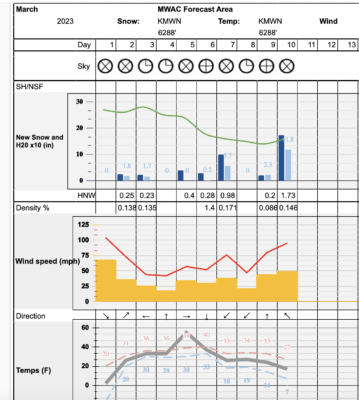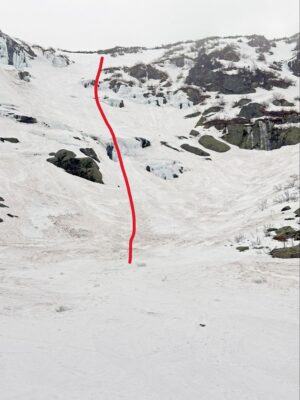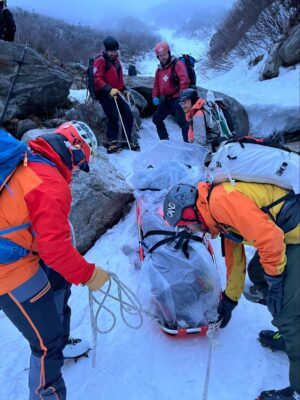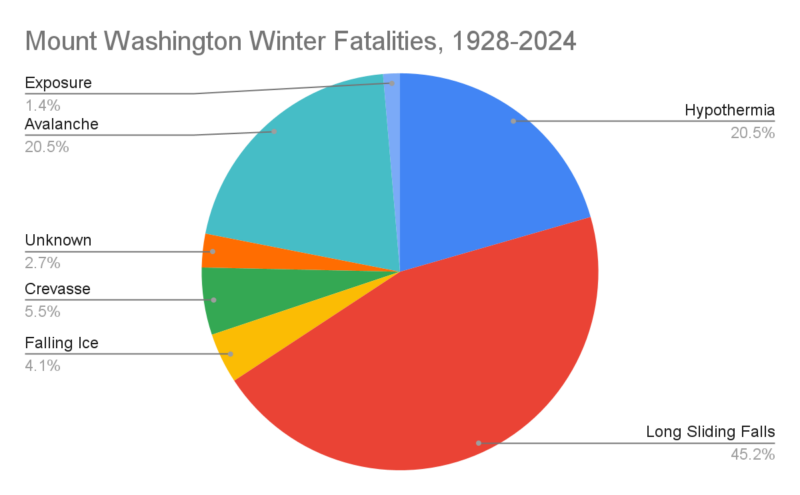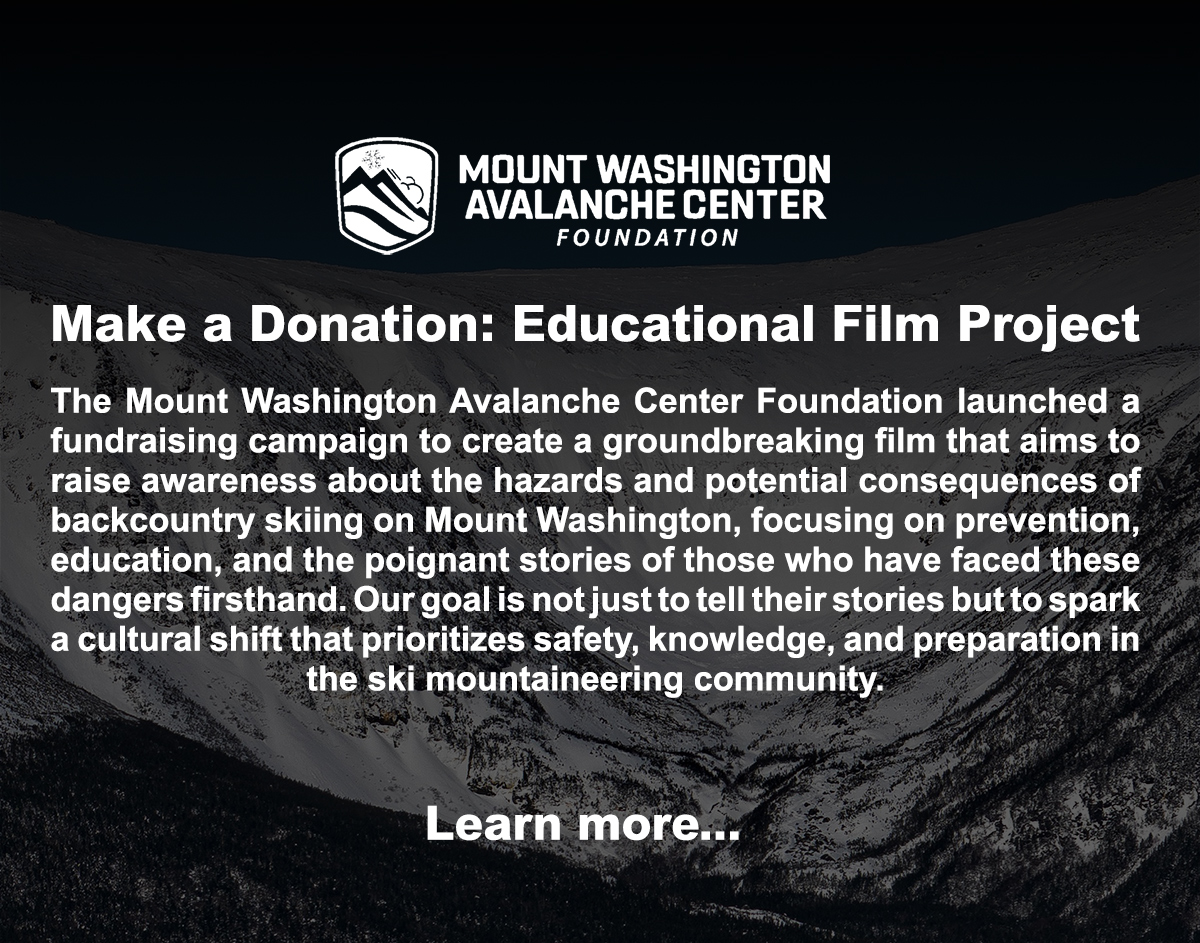At approximately 2:30 pm on Saturday, March 9th 2024, a party of two ascended Left Gully with the intention of skiing a slope in Tuckerman Ravine. The party traveled on foot across the top of the ravine towards an area above The Lip when both in the party slipped and fell approximately 600 vertical feet to the bottom of the ravine. The falls resulted in a fatality for one individual (Patient 1) and life threatening injuries to the other (Patient 2). Mount Washington Avalanche Center (MWAC) Snow Rangers, Mount Washington Volunteer Ski Patrol (MWVSP), and willing bystanders assisted with rescue and recovery efforts of Patients 1 and 2 along with an additional rescue of a third person (Patient 3) that sustained critical injuries from a long sliding fall in Hillman’s Highway in roughly the same timespan.
Weather/Snowpack:
Over the week prior to the accidents, the Presidential Range saw several days of above freezing temperatures and rain, resulting in a loss of 12 inches to the snowpack at the Mount Washington summit and similar losses at ravine level. Just under 2 inches of rain was recorded throughout the week and on March 6th, Mount Washington Observatory set a new record for daily high temperature at 40 degrees F. Temperatures dropped back below freezing on March 7th and the snowpack refroze over the next several days. On Saturday, March 9th, the summit of Mount Washington recorded an average temperature of 24 degrees F, skies were obscured due to fog and south winds averaged 43.5 mph. The snowpack was refrozen and firm with decreased coverage, exposing rocks, deep holes, and ice throughout Tuckerman Ravine.
The avalanche hazard rating for Saturday, March 9th was LOW with no avalanche problem listed. The avalanche forecast “Bottom Line” read:
You are unlikely to trigger an avalanche today. Use normal cautions when traveling in avalanche terrain and carefully assess for springtime mountain hazards to help reduce your exposure. Significant snow and strong winds after dark are likely to create dangerous avalanche conditions.
Events:
At approximately 2:30 pm, MWAC and MWVSP, who were in the process of leaving the ravine, were alerted to an emergency in the bottom of Tuckerman Ravine. At approximately 2:40 pm, rescuers arrived on scene where bystanders were already assisting Patient 1 and Patient 2, who were witnessed falling from near the top of The Lip to the ravine floor. Among the assisting bystanders for Patient 1 was a critical care physician, who assessed injuries incompatible with life, sustained during the fall.
Patient 2 was assessed to have critical injuries and in need of immediate evacuation to Advanced Life Support. A request for helicopter air transport was made at approximately 2:50 pm, but was denied due to weather constraints from fog and low clouds. Rescuers began the extrication of both patients in rescue litters down the Tuckerman Ravine Trail to Hermit Lake. This process involved two separate teams of rescuers and bystanders belaying litters down sections of steep and icy terrain and took approximately 1 hour. Patients 1 & 2 arrived at Hermit Lake at approximately 3:45 pm, and Patient 2 was transferred to a snowcat with rescuers and rapidly transported down to Pinkham Notch Visitor Center (AMC) where Gorham EMS was waiting and assumed care.
At approximately 4:00 pm, while rescuers were still transporting Patient 2, MWAC was alerted to another injury in Hillman’s Highway. The remaining rescue team transitioned efforts to Patient 3 who had also suffered critical injuries due to a long sliding fall. At approximately 5:15 pm, Patient 3 had been stabilized and packaged in a rescue litter and teams belayed Patient 3 down to the bottom of Hillman’s Highway. At approximately 6:00 pm, Patient 3 was transferred to the snowcat with rescuers and transported to Pinkham Notch Visitor Center. Gorham EMS assumed care of Patient 3 at approximately 6:45 pm. State officials joined the rescue team to assist with the transport of Patient 1 down to Pinkham via snowcat and all rescue efforts were completed by approximately 10:00 pm.
Summary:
The greater Mount Washington area is known for its dangerous and deadly conditions. Although hypothermia and avalanches kill many people, the majority of fatalities during the winter are due to long sliding falls.
Prior to the accidents on Saturday March 9th, several long sliding falls were witnessed that did not result in serious injury. It’s difficult to predict conditions that are conducive to this hazard because of the dramatic and unpredictable weather off the summit of Mount Washington. These weather impacts at ravine elevations are not necessarily the same in terrain at lower elevations. Snow conditions, in particular, can be soft and edgeable at the beginning of an ascent, then rapidly transition to firm ice that is impenetrable with ski edges and ice axes. The higher into terrain visitors travel, the more consequential a fall may be.
National Forests, like the White Mountain National Forest, are resources open to anyone and everyone who wants to visit and explore these beautiful places. Tuckerman Ravine presents an extremely high risk environment for skiers, climbers, and hikers that is often perceived as an easy access location for backcountry adventures. Because of this, the ravine sees thousands of visitors throughout the winter and spring. However, the terrain is technical, unmitigated for hazards, unpredictable, and remote. Access to rescue resources are extremely limited and often transport to Advanced Life Support can be hours away. Forest Service staff and committed volunteers do their best to provide messaging and rescue services to their fellow outdoor enthusiasts, but the tragic events of this incident underline the reality of this iconic terrain.
The Mount Washington Avalanche Center would like to extend our sincerest condolences to the family and friends of the deceased.
We would also like to express our sincerest thanks and gratitude to the many bystanders who voluntarily assisted during all three incidents.
